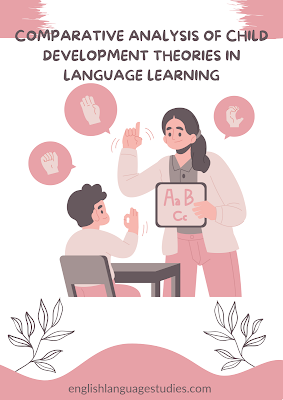Language acquisition is one of the most fascinating aspects of child development, and over the years, various theorists have proposed different perspectives on how children learn languages. Some argue that language is an innate ability, while others believe it is shaped by social interactions or cognitive development. In this blog post, we will compare major child development theories—Behaviorism, Nativism, Social Interactionism, and Cognitive Development Theory—to understand their role in language learning.
1. Behaviorism (B.F. Skinner) – Learning Through Reinforcement
Key Idea:
Behaviorist theory, proposed by B.F. Skinner, suggests that language learning is based on conditioning. Children acquire language through imitation, repetition, reinforcement (rewards and corrections), and association with stimuli.
How It Relates to Language Learning:
- A child says "mama," and the mother responds with a smile and attention—this reinforces the behavior.
- Language is learned through positive reinforcement (e.g., praise) and negative reinforcement (e.g., correction of mistakes).
- The environment plays a crucial role, and without exposure, language development would not occur.
Criticism:
- Behaviorism underestimates the child's ability to generate novel sentences.
- It does not explain why children make grammatical errors they have never heard before (e.g., "goed" instead of "went").
- Language learning is too complex to rely solely on reinforcement.
2. Nativism (Noam Chomsky) – The Innate Language Faculty
Key Idea:
Chomsky’s Universal Grammar (UG) theory proposes that children are born with an inherent ability to learn language. He introduced the Language Acquisition Device (LAD)—a hypothetical brain mechanism that helps children understand grammar rules effortlessly.
How It Relates to Language Learning:
- Children can learn any language naturally if exposed to it.
- They acquire complex grammatical structures even without direct teaching.
- The ability to learn language is universal across cultures and does not depend solely on external reinforcement.
Criticism:
- It does not explain the role of social interaction in language learning.
- There is little neurological evidence to prove the existence of an LAD.
- It overlooks how environment and experience influence language acquisition.
3. Social Interactionism (Lev Vygotsky) – Learning Through Social Engagement
Key Idea:
Vygotsky emphasized that social interaction is key to language development. He believed that language is learned through communication with parents, caregivers, and peers. His Zone of Proximal Development (ZPD) concept suggests that children learn best when guided by more knowledgeable individuals.
How It Relates to Language Learning:
- Caregivers play a crucial role by scaffolding (providing structured support).
- Language develops first through social interaction before becoming an internal cognitive process.
- Children actively participate in dialogues, leading to gradual learning.
Criticism:
- It does not fully explain how children develop grammar without explicit teaching.
- The theory is more focused on social aspects than on the biological or cognitive mechanisms behind language learning.
4. Cognitive Development Theory (Jean Piaget) – Language as a Part of Thinking
Key Idea:
Piaget believed that language development depends on cognitive growth. He argued that children must first develop certain cognitive abilities before they can acquire language.
How It Relates to Language Learning:
- Language is a byproduct of overall cognitive development.
- Children learn words after they understand the concept behind them (e.g., a child learns the word "big" after grasping the concept of size).
- Language skills improve as thinking abilities mature.
Criticism:
- Some children acquire language even before they fully understand abstract concepts.
- It underestimates the role of social interaction in language learning.
- Piaget focused more on overall intellectual development rather than the specifics of language acquisition.
Final Thoughts: A Balanced Perspective
No single theory fully explains language acquisition. Instead, a combination of theories provides a more comprehensive understanding:
- Behaviorism explains early vocabulary learning through imitation and reinforcement.
- Nativism justifies why children can grasp complex grammar rules without direct teaching.
- Social Interactionism highlights the importance of communication and guidance from caregivers.
- Cognitive Development Theory connects language learning to broader intellectual growth.
Modern research suggests that language learning is an interplay of biological, cognitive, and social factors. While some aspects of language may be innate, exposure to social interaction and cognitive development is equally important for mastering a language.
So, the next time you hear a toddler say something like "I goed to the park", remember—they're not just mimicking; they're actively constructing grammar rules in their little genius brains!



No comments:
Post a Comment